Yamaha XMAX300 TECH MAX (2024) Manual
Læs gratis den danske manual til Yamaha XMAX300 TECH MAX (2024) (137 sider) i kategorien Scooter. Denne vejledning er vurderet som hjælpsom af 81 personer og har en gennemsnitlig bedømmelse på 4.6 stjerner ud af 41 anmeldelser. Har du et spørgsmål om Yamaha XMAX300 TECH MAX (2024), eller vil du spørge andre brugere om produktet?
Side 1/137

CZD250D-A (XMAX 250 TECH MAX)
CZD300D-A (XMAX 300 TECH MAX)
1
2
3
4
5
6
7
8
9
10
11
12
BMK-F8199-EC
Read this manual carefully
before operating this vehicle.
MOTORCYCLE
OWNER’S MANUAL
Specifications
Consumer information
Scooter care and storage
Periodic maintenance and adjustment
For your safety – pre-operation checks
Instrument and control functions
Smartphone Connectivity System
Smart key system
Description
Safety information
Operation and important riding points
Index

EAU81566
Read this manual carefully before operating this vehicle. This manual should stay with this vehicle if it is sold.
EAU81597
For Europe
Declaration of Conformity:
Hereby, MITSUBISHI ELECTRIC MOBILITY CORPORATION declares that the radio equipment type, Smart Keyless Sys-
tem (SKEA7E-04, SKEA7E-06, SKEA7E-03) is in compliance with Directive 2014/53/EU.
The full text of the EU declaration of conformity is available at the following internet address:
http://www.mitsubishielectric.com/bu/automotive/doc/re.html
Smart Unit: SKEA7E-04, SKEA7E-06
Operation frequency: 125 kHz
Maximum output power: 117 dBuV/m at 10 meters
Hand Unit: SKEA7E-03
Operation frequency: 433.92 MHz
Maximum output power: 10 mW
Manufacturer:
MITSUBISHI ELECTRIC MOBILITY CORPORATION
840, Chiyoda-machi, Himeji, Hyogo 670-8677, Japan
Importer:
YAMAHA MOTOR EUROPE N.V.
Koolhovenlaan 101, 1119 NC Schiphol-Rijk, 1117 ZN, Schiphol, the Netherlands

EAU94454
For UK
Declaration of Conformity:
Hereby, MITSUBISHI ELECTRIC MOBILITY CORPORATION, declares that the radio equipment type, Smart Keyless Sys-
tem (SKEA7E-04, SKEA7E-06, SKEA7E-03) is in compliance with the Radio Equipment Regulations 2017.
The full text of the declaration of conformity is available at the following internet address:
http://www.mitsubishielectric.com/bu/automotive/doc/ukgb.html
Smart Unit: SKEA7E-04, SKEA7E-06
Operation frequency: 125 kHz
Maximum output power: 117 dBuV/m at 10 meters
Hand Unit: SKEA7E-03
Operation frequency: 433.92 MHz
Maximum output power: 10 mW
Manufacturer:
MITSUBISHI ELECTRIC MOBILITY CORPORATION
840, Chiyoda-machi, Himeji, Hyogo 670-8677, Japan
Importer:
YAMAHA MOTOR EUROPE N.V., BRANCH UK
Units A2-A3, Kingswey Business Park, Forsyth Road, Woking, Surrey. GU21 5SA. United Kingdom.

EAUM5231
For Ukraine
EAUM5241
For Serbia
справжнім MITSUBISHI ELECTRIC MOBILILTY CORPORATION заявляє що тип
радіообладнання (SKEA7E-02, SKEA7E-03, SKEA7E-04, SKEA7E-06)
відповідає Технічному регламенту радіообладнання.
Повний текст декларації про відповідність доступний на веб-сайті за такою адресою:
http://www.mitsubishielectric.com/bu/automotive/doc/ukr.html

EAUM5251
For Moldova
EAUM5261
For Israel
Prin prezenta, MITSUBISHI ELECTRIC MOBILITY CORPORATION declară că tipul de echipamente radio
Smart Keyless System (SKEA7E-02, SKEA7E-03, SKEA7E-04, SKEA7E-06)
este în conformitate cu Reglementarea tehnică „Punerea la dispoziție pe piață a echipamentelor radio” .
Textul integral al declaraței de conformitate este disponibil la urmăoarea adresăde internet:
http://www.mitsubishielectric.com/bu/automotive/doc/mda.html
Importator:
Motodynamics S.A.
Germanikis Scholis Athinon 10, 15123, Marousi, Grecia
55-05938(SKEA7E-03),55-13677(SKEA7E-04),51-99856(SKEA7E-06)
:מספראישורהתאמהמטעםמשרדהתקשורת
"חלאיסורלבצעפעולותבמכשירשישבהןכדילשנותאתתכונותיוהאלחוטיות
שלהמכשיר,ובכללזהשינוייתוכנה,החלפתאנטנהמקוריתאוהוספתאפשרות
לחיבורלאנטנהחיצונית,בלאקבלתאישורמשרדהתקשורת,בשלהחשש
להפרעותאלחוטיות."

EAUM5080
For Europe
Declaration of Conformity:
Hereby, PT. Indonesia Nippon Seiki declares that the radio equipment type, Motorcycle Cluster, YA-1335 is in compliance
with Directive 2014/53/EU.
The full text of the EU declaration of conformity is available at the following internet address:
https://global.yamaha-motor.com/eu_doc/
Frequency band: 2400~2483.5 MHz
Transmit power: -6~-5 dBm
Manufacturer:
PT. Indonesia Nippon Seiki
JL. Utama Modern Industri Blok E, Kawasan Industri
Modern Cikande Serang-Banten, INDONESIA
Importer:
YAMAHA MOTOR EUROPE N.V.
Koolhovenlaan 101, 1119 NC Schiphol-Rijk, 1117 ZN, Schiphol, the Netherlands

EAUN3941
Use of trade marks
The Bluetooth® word mark and logos are registered trademarks owned by Bluetooth SIG, Inc.
iOS is a registered trademark or trademark of Cisco Systems, Inc. and/or its affiliates in the United States and certain other
countries.
Android is a trademark of Google LLC.
Garmin StreetCross™ is a trademark of Garmin Ltd.

Introduction
EAU10114
Welcome to the Yamaha world of motorcycling!
As the owner of the CZD250D-A/CZD300D-A, you are benefiting from Yamaha’s vast experience and newest technology
regarding the design and manufacture of high-quality products, which have earned Yamaha a reputation for dependability.
Please take the time to read this manual thoroughly, so as to enjoy all advantages of your CZD250D-A/CZD300D-A. The
Owner’s Manual does not only instruct you in how to operate, inspect and maintain your scooter, but also in how to safe-
guard yourself and others from trouble and injury.
In addition, the many tips given in this manual will help keep your scooter in the best possible condition. If you have any
further questions, do not hesitate to contact your Yamaha dealer.
The Yamaha team wishes you many safe and pleasant rides. So, remember to put safety first!
Yamaha continually seeks advancements in product design and quality. Therefore, while this manual contains the most cur-
rent product information available at the time of printing, there may be minor discrepancies between your scooter and this
manual. If there is any question concerning this manual, please consult a Yamaha dealer.
WARNING
EWA12412
Please read this manual carefully and completely before operating this scooter.

Important manual information
EAUM5170
CZD250D-A/CZD300D-A
OWNER’S MANUAL
©2024 by Yamaha Motor Manufacturing
Europe
1st edition, May 2024
All rights reserved
Any reprinting or unauthorized use
without the written permission of
Yamaha Motor Manufacturing Europe
is expressly prohib dite .
Printed in France.

Table of contents
Safety information............................ 1-1
Further safe-riding points ............... 1-5
Description ....................................... 2-1
Left view ......................................... 2-1
Right view....................................... 2-2
Controls and instruments ............... 2-3
Smart key system ........................... 3-1
Smart key system........................... 3-1
Operating range of the smart key
system......................................... 3-2
Handling of the smart key and
mechanical keys ......................... 3-3
Smart key ....................................... 3-5
Replacing the smart key battery..... 3-6
Main switch .................................... 3-7
Smartphone Connectivity
System .............................................. 4-1
Smart features: Introduction........... 4-1
Initial setup ..................................... 4-3
Telephone....................................... 4-6
Connection troubleshooting........... 4-8
Instrument and control functions... 5-1
Indicator lights and warning
lights............................................ 5-1
Dual Displays.................................. 5-3
Main display ................................... 5-3
Infotainment display ....................... 5-5
Menu system.................................5-11
Handlebar switches ......................5-21
Front brake lever...........................5-23
Rear brake lever ............................5-23
ABS ...............................................5-23
Traction control system ................5-24
Fuel tank cap ................................5-26
Fuel ...............................................5-27
Fuel tank overflow hose ................5-29
Catalytic converter........................5-29
Storage compartments .................5-29
Windscreen ...................................5-31
Handlebar position .......................5-33
Adjusting the shock absorber
assemblies.................................5-33
Power outlet .................................5-34
DC connectors..............................5-35
Sidestand ......................................5-35
Ignition circuit cut-off system .......5-36
For your safety – pre-operation
checks ...............................................6-1
Operation and important rid gin
points .................................................7-1
Engine break-in ...............................7-1
Starting the engine..........................7-2
Starting off ......................................7-3
Acceleration and deceleration ........7-3
Braking............................................7-4
Tips for reducing fuel
consumption ............................... 7-4
Parking............................................ 7-5
Periodic maintenance and
adjustment........................................ 8-1
Tool kit ............................................ 8-2
Periodic maintenance charts.......... 8-3
Periodic maintenance chart for
the emission control system ....... 8-3
General maintenance and
lubrication chart .......................... 8-4
Removing and installing the
panel............................................ 8-8
Checking the spark plug................. 8-8
Canister .......................................... 8-9
Engine oil ...................................... 8-10
Why Yamalube.............................. 8-11
Final transmission oil .................... 8-11
Coolant ......................................... 8-11
Air filter and V-belt case air filter
elements.................................... 8-13
Checking the throttle grip free
play............................................ 8-17
Valve clearance............................. 8-17
Tires.............................................. 8-18
Cast wheels .................................. 8-19
Checking the front and rear
brake lever free play.................. 8-20
Checking the front and rear
brake pads ................................ 8-20

Table of contents
Checking the brake fluid level .......8-21
Changing the brake fluid ...............8-22
Checking the V-belt.......................8-23
Checking and lubricating the
cables.........................................8-23
Checking and lubricating the
throttle grip and cable................8-23
Lubricating the front and rear
brake levers................................8-24
Checking and lubricating the
centerstand and sidestand ........8-24
Checking the front fork..................8-25
Checking the steering ...................8-26
Checking the wheel bearings ........8-26
Battery...........................................8-26
Replacing the fuses.......................8-28
Vehicle lights .................................8-29
Replacing the license plate light
bulb ............................................8-29
Troubleshooting ............................8-30
Troubleshooting chart ...................8-32
Emergency mode .........................8-34
Scooter care and storage................9-1
Matte color caution .........................9-1
Care.................................................9-1
Storage............................................9-4
Specifications ................................. 10-1
Consumer information................... 11-1
Identification numbers .................. 11-1
Diagnostic connector.................... 11-2
Use of your data ........................... 11-3
Index................................................ 12-1

1-1
1
Safety information
EAU1026B
Be a Responsible Owner
As the vehicle’s owner, you are re-
sponsible for the safe and proper oper-
ation of your scooter.
Scooters are single-track vehicles.
Their safe use and operation are de-
pendent upon the use of proper riding
techniques as well as the expertise of
the operator. Every operator should
know the following requirements be-
fore riding this scooter.
He or she should:
Obtain thorough instructions from
a competent source on all aspects
of scooter operation.
Observe the warnings and mainte-
nance requirements in this Own-
er’s Manual.
Obtain qualified training in safe
and proper riding techniques.
Obtain professional technical ser-
vice as indicated in this Owner’s
Manual and/or when made neces-
sary by mechanical conditions.
Never operate a scooter without
proper training or instruction. Take
a training course. Beginners
should receive training from a cer-
tified instructor. Contact an autho-
rized scooter dealer to find out
about the training courses nearest
you.
Safe Rid gin
Perform the pre-operation checks
each time you use the vehicle to make
sure it is in safe operating condition.
Failure to inspect or maintain the vehi-
cle properly increases the possibility of
an accident or equipment damage.
See page 6-1 for a list of pre-operation
checks.
This scooter is designed to carry
the operator and a passenger.
The failure of motorists to detect
and recognize scooters in traffic is
the predominating cause of auto-
mobile/scooter accidents. Many
accidents have been caused by
an automobile driver who did not
see the scooter. Making yourself
conspicuous appears to be very
effective in reducing the chance of
this type of accident.
Therefore:
• Wear a brightly colored jacket.
• Use extra caution when you are
approaching and passing
through intersections, since in-
tersections are the most likely
places for scooter accidents to
occur.
• Ride where other motorists can
see you. Avoid riding in another
motorist’s blind spot.
• Never maintain a scooter with-
out proper knowledge. Contact
an authorized scooter dealer to
inform you on basic scooter
maintenance. Certain mainte-
nance can only be carried out
by certified staff.

Safety information
1-2
1
Many accidents involve inexperi-
enced operators. In fact, many op-
erators who have been involved in
accidents do not even have a cur-
rent driver’s license.
• Make sure that you are qualified
and that you only lend your
scooter to other qualified opera-
tors.
• Know your skills and limits.
Staying within your limits may
help you to avoid an accident.
• We recommend that you prac-
tice riding your scooter where
there is no traffic until you have
become thoroughly familiar with
the scooter and all of its con-
trols.
Many accidents have been
caused by error of the scooter op-
erator. A typical error made by the
operator is veering wide on a turn
due to excessive speed or under-
cornering (insufficient lean angle
for the speed).
• Always obey the speed limit and
never travel faster than warrant-
ed by road and traffic condi-
tions.
• Always signal before turning or
changing lanes. Make sure that
other motorists can see you.
The posture of the operator and
passenger is important for proper
control.
• The operator should keep both
hands on the handlebar and
both feet on the operator foot-
rests during operation to main-
tain control of the scooter.
• The passenger should always
hold onto the operator, the seat
strap or grab bar, if equipped,
with both hands and keep both
feet on the passenger footrests.
Never carry a passenger unless
he or she can firmly place both
feet on the passenger footrests.
Never ride under the influence of
alcohol or other drugs.
This scooter is designed for on-
road use only. It is not suitable for
off-road use.
Protective Apparel
The majority of fatalities from scooter
accidents are the result of head inju-
ries. The use of a safety helmet is the
single most critical factor in the pre-
vention or reduction of head injuries.
Always wear an approved helmet.
Wear a face shield or goggles.
Wind in your unprotected eyes
could contribute to an impairment
of vision that could delay seeing a
hazard.
The use of a jacket, substantial
shoes, trousers, gloves, etc., is ef-
fective in preventing or reducing
abrasions or lacerations.
Never wear loose-fitting clothes,
otherwise they could catch on the
control levers or wheels and cause
injury or an accident.
Always wear protective clothing
that covers your legs, ankles, and
feet. The engine or exhaust sys-
tem become very hot during or af-
ter operation and can cause
burns.
A passenger should also observe
the above precautions.

Safety information
1-3
1Avoid Carbon Monoxide Poisoning
All engine exhaust contains carbon
monoxide, a deadly gas. Breathing
carbon monoxide can cause head-
aches, dizziness, drowsiness, nausea,
confusion, and eventually death.
Carbon Monoxide is a colorless, odor-
less, tasteless gas which may be pres-
ent even if you do not see or smell any
engine exhaust. Deadly levels of car-
bon monoxide can collect rapidly and
you can quickly be overcome and un-
able to save yourself. Also, deadly lev-
els of carbon monoxide can linger for
hours or days in enclosed or poorly
ventilated areas. If you experience any
symptoms of carbon monoxide poi-
soning, leave the area immediately, get
fresh air, and SEEK MEDICAL TREAT-
MENT.
Do not run engine indoors. Even if
you try to ventilate engine exhaust
with fans or open windows and
doors, carbon monoxide can rap-
idly reach dangerous levels.
Do not run engine in poorly venti-
lated or partially enclosed areas
such as barns, garages, or car-
ports.
Do not run engine outdoors where
engine exhaust can be drawn into
a building through openings such
as windows and doors.
Loading
Adding accessories or cargo to your
scooter can adversely affect stability
and handling if the weight distribution
of the scooter is changed. To avoid the
possibility of an accident, use extreme
caution when adding cargo or acces-
sories to your scooter. Use extra care
when riding a scooter that has added
cargo or accessories. Here, along with
the information about accessories be-
low, are some general guidelines to fol-
low if loading cargo to your scooter:
The total weight of the operator, pas-
senger, accessories and cargo must
not exceed the maximum load limit.
Operation of an overloaded vehicle
could cause an accident.
When loading within this weight limit,
keep the following in mind:
Cargo and accessory weight
should be kept as low and close to
the scooter as possible. Securely
pack your heaviest items as close
to the center of the vehicle as pos-
sible and make sure to distribute
the weight as evenly as possible
on both sides of the scooter to
minimize imbalance or instability.
Shifting weights can create a sud-
den imbalance. Make sure that
accessories and cargo are se-
curely attached to the scooter be-
fore riding. Check accessory
mounts and cargo restraints fre-
quently.
• Properly adjust the suspension
for your load (suspension-ad-
justable models only), and
check the condition and pres-
sure of your tires.
• Never attach any large or heavy
items to the handlebar, front
fork, or front fender. Such items
can create unstable handling or
a slow steering response.
This vehicle is not d gesi ned to
pull a trailer or to be attached to
a sidecar.
Maximum load:
163 kg (360 lb)

Safety information
1-4
1
Genuine Yamaha Accessories
Choosing accessories for your vehicle
is an important decision. Genuine
Yamaha accessories, which are avail-
able only from a Yamaha dealer, have
been designed, tested, and approved
by Yamaha for use on your vehicle.
Many companies with no connection
to Yamaha manufacture parts and ac-
cessories or offer other modifications
for Yamaha vehicles. Yamaha is not in
a position to test the products that
these aftermarket companies produce.
Therefore, Yamaha can neither en-
dorse nor recommend the use of ac-
cessories not sold by Yamaha or
modifications not specifically recom-
mended by Yamaha, even if sold and
installed by a Yamaha dealer.
Aftermarket Parts, Accessories, and
Modifications
While you may find aftermarket prod-
ucts similar in design and quality to
genuine Yamaha accessories, recog-
nize that some aftermarket accesso-
ries or modifications are not suitable
because of potential safety hazards to
you or others. Installing aftermarket
products or having other modifications
performed to your vehicle that change
any of the vehicle’s design or operation
characteristics can put you and others
at greater risk of serious injury or
death. You are responsible for injuries
related to changes in the vehicle.
Keep the following guidelines in mind,
as well as those provided under “Load-
ing” when mounting accessories.
Never install accessories or carry
cargo that would impair the per-
formance of your scooter. Careful-
ly inspect the accessory before
using it to make sure that it does
not in any way reduce ground
clearance or cornering clearance,
limit suspension travel, steering
travel or control operation, or ob-
scure lights or reflectors.
• Accessories fitted to the han-
dlebar or the front fork area can
create instability due to improp-
er weight distribution or aerody-
namic changes. If accessories
are added to the handlebar or
front fork area, they must be as
lightweight as possible and
should be kept to a minimum.
• Bulky or large accessories may
seriously affect the stability of
the scooter due to aerodynamic
effects. Wind may attempt to lift
the scooter, or the scooter may
become unstable in cross
winds. These accessories may
also cause instability when
passing or being passed by
large vehicles.
• Certain accessories can dis-
place the operator from his or
her normal riding position. This
improper position limits the
freedom of movement of the
operator and may limit control
ability, therefore, such accesso-
ries are not recommended.
Use caution when adding electri-
cal accessories. If electrical ac-
cessories exceed the capacity of
the scooter’s electrical system, an
electric failure could result, which
could cause a dangerous loss of
lights or engine power.

Safety information
1-6
1
Always wear a helmet, gloves,
trousers (tapered around the cuff
and ankle so they do not flap), and
a brightly colored jacket.
Do not carry too much luggage on
the scooter. An overloaded scoot-
er is unstable. Use a strong cord
to secure any luggage to the carri-
er (if equipped). A loose load will
affect the stability of the scooter
and could divert your attention
from the road. (See page 1-3.)

Description
2-2
2
EAU10421
Right view
1. Tail light
2. Rear turn signal light
3. Rear storage compartment (page 5-29)
4. Fuel tank cap (page 5-26)
5. Storage compartment B (page 5-29)
6. Windscreen (page 5-31/8-28)
7. Front turn signal light
8. Battery (page 8-26)
9. Fuses (page 8-28)
10.Headlight (page 8-29)
11.Auxiliary light (page 8-29)
12.Centerstand (page 8-24)
13.Engine oil level check window (page 8-10)
14.Engine oil filler cap (page 8-10)

Smart key system
3-1
3
EAU76444
Smart key system
The smart key system enables you to
operate the vehicle without using a
mechanical key. In addition, there is an
answer-back function to help you lo-
cate the vehicle in a parking lot. (See
page 3-5.)
WARNING
EWA14704
Keep implanted pacemakers or
cardiac defibrillators, as well as
other electric med dical evices
away from the vehicle mounted
antenna (see illustration).
Radio waves transmitted b y the
antenna may affect the opera-
tion of such devices when close
by.
If you have an electric medical
device, consult a doctor or the
d bevice manufacturer efore us-
ing this vehicle.
NOTICE
ECA24080
The smart key system uses weak ra-
dio waves. The smart key system
may not work in the following situa-
tions.
The smart key is placed in a lo-
cation exposed to strong radio
waves or other electromagnetic
noise
There are facilities nearby that
are emitting strong radio waves
(TV or radio towers, power
plants, broadcasting stations,
airports, etc.)
1. Smart key
2. Smart key button
1
2
1. Main switch
2. Main switch knob
2
1
1. Vehicle mounted antenna
1

Smartphone Connectivity System
4-3
4
EAU99109
Initial setup
This section describes the basic setup
procedures to connect your smart-
phone to the CCU and start using
smart features.
1. Download/install the MyRide app
on your smartphone via an appli-
cation store. Complete the instal-
lation and pair/connect it to the
CCU via Bluetooth.
2. To use the navigation system,
download/install the Garmin
StreetCross app. Complete the in-
stallation and pair/connect it to the
CCU via Bluetooth.
3. To use the audio/phone/naviga-
tion system route guidance,
pair/connect a Bluetooth headset
to your smartphone. (See page
4-6.).
MyRide pairing
NOTICE
ECAN0150
The Bluetooth connection may not
work in the following situations.
In a location exposed to strong
radio waves or other electro-
magnetic noise.
At facilities nearby that are
emitting strong radio waves (TV
or radio towers, power plants,
b droa casting stations, airports,
etc.).
1. Download and install the MyRide
app on your smartphone.
2. Short press the “ ” switch to
open the menu system. Navigate
to: “ Settings” → “Connection”
→ “Bluetooth”.
3. Make sure there is a blue check-
mark next to “Bluetooth” and se-
lect “Discovery mode”.
4. Open the MyRide app and navi-
gate to the “Pairing” screen. Fol-
low the instructions on the app to
detect the CCU and pair/connect
with it.

Smartphone Connectivity System
4-4
4
TIP
After making the CCU discoverable, a
pairing must be completed within 3
minutes or the process will fail. If a fail-
ure occurs, select “Discovery mode”
again to retry.
5. A request for Bluetooth pairing will
appear with a passkey matching
the one displayed on the smart-
phone. Use the “ ”/“ ” switch-
es to highlight “Yes” and then
short press the “ ” switch.
6. Accept the pairing request on your
smartphone.
TIP
After the passkey appears, the
pairing must be confirmed within
30 seconds or it will time out. If a
failure occurs, select “Discovery
mode” again to retry.
When connected, the MyRide in-
dicator icon “ ” will appear on the
top of the infotainment display
and also next to the connected
smartphone device name in the
“Paired devices” list. (See page
5-16.)
TIP
A request will appear on your
smartphone to share contact in-
formation with the vehicle. If you
decline to upload the data to the
CCU and/or allow access to notifi-
cations, you can do so later in your
smartphone’s settings.
If a Bluetooth pairing record is de-
leted from the smartphone, then
the corresponding pairing record
must be deleted from the “Paired
devices” list in order to pair again
successfully.
If a Bluetooth pairing record is de-
leted from the “Paired devices”
list, then the corresponding pair-
ing record must be deleted from
the smartphone in order to pair
again successfully.
The first time the vehicle is paired
with the MyRide app, the menu
system language will change to
match the language selected in
the app. When first installed, the
app adopts the system language
of the smartphone. If the language
is not supported by the CCU, then
English will be automatically se-
lected.
Once paired, the MyRide app will
open automatically when a
Bluetooth connection is estab-
lished and will connect to the CCU
automatically (This functionality
varies by smartphone and/or OS
versions. Refer to the MyRide app
for more details).
Produkt Specifikationer
| Mærke: | Yamaha |
| Kategori: | Scooter |
| Model: | XMAX300 TECH MAX (2024) |
Har du brug for hjælp?
Hvis du har brug for hjælp til Yamaha XMAX300 TECH MAX (2024) stil et spørgsmål nedenfor, og andre brugere vil svare dig
Scooter Yamaha Manualer
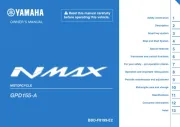
11 September 2025
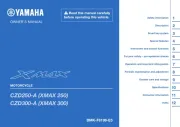
10 August 2025
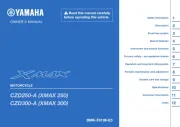
10 August 2025
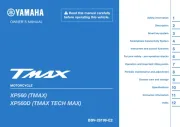
10 August 2025
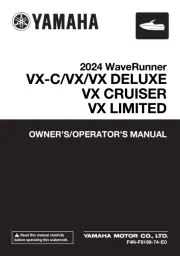
10 August 2025
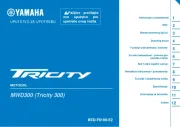
10 August 2025
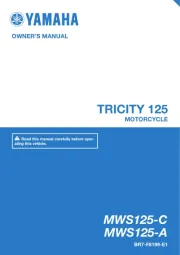
10 August 2025
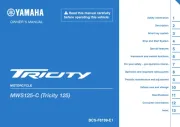
10 August 2025
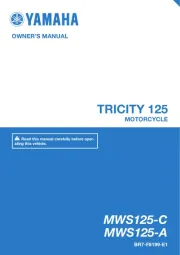
9 August 2025
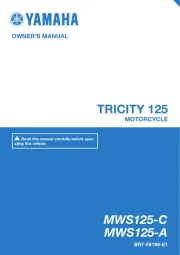
9 August 2025
Scooter Manualer
- Kingsong
- Nils Extreme
- Giantco
- Apollo
- Turbho
- Prixton
- Denver
- Vorago
- Hero
- Qwic
- Silent Force
- Honda
- Derbi
- Sachs
- MS Energy
Nyeste Scooter Manualer
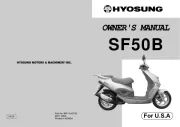
7 Oktober 2025
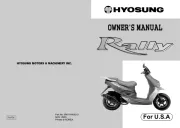
6 Oktober 2025

2 Oktober 2025
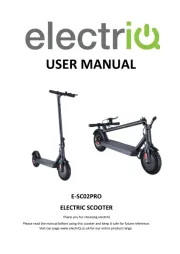
2 Oktober 2025

30 September 2025

30 September 2025

29 September 2025
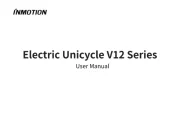
17 September 2025
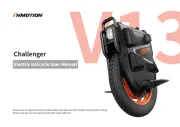
16 September 2025
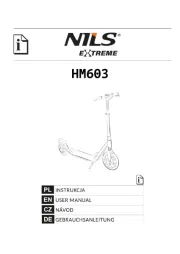
16 September 2025